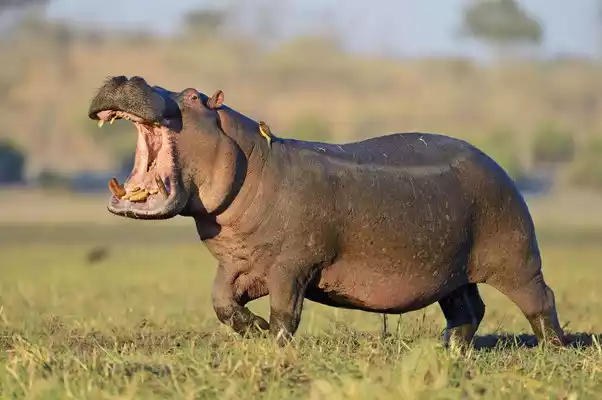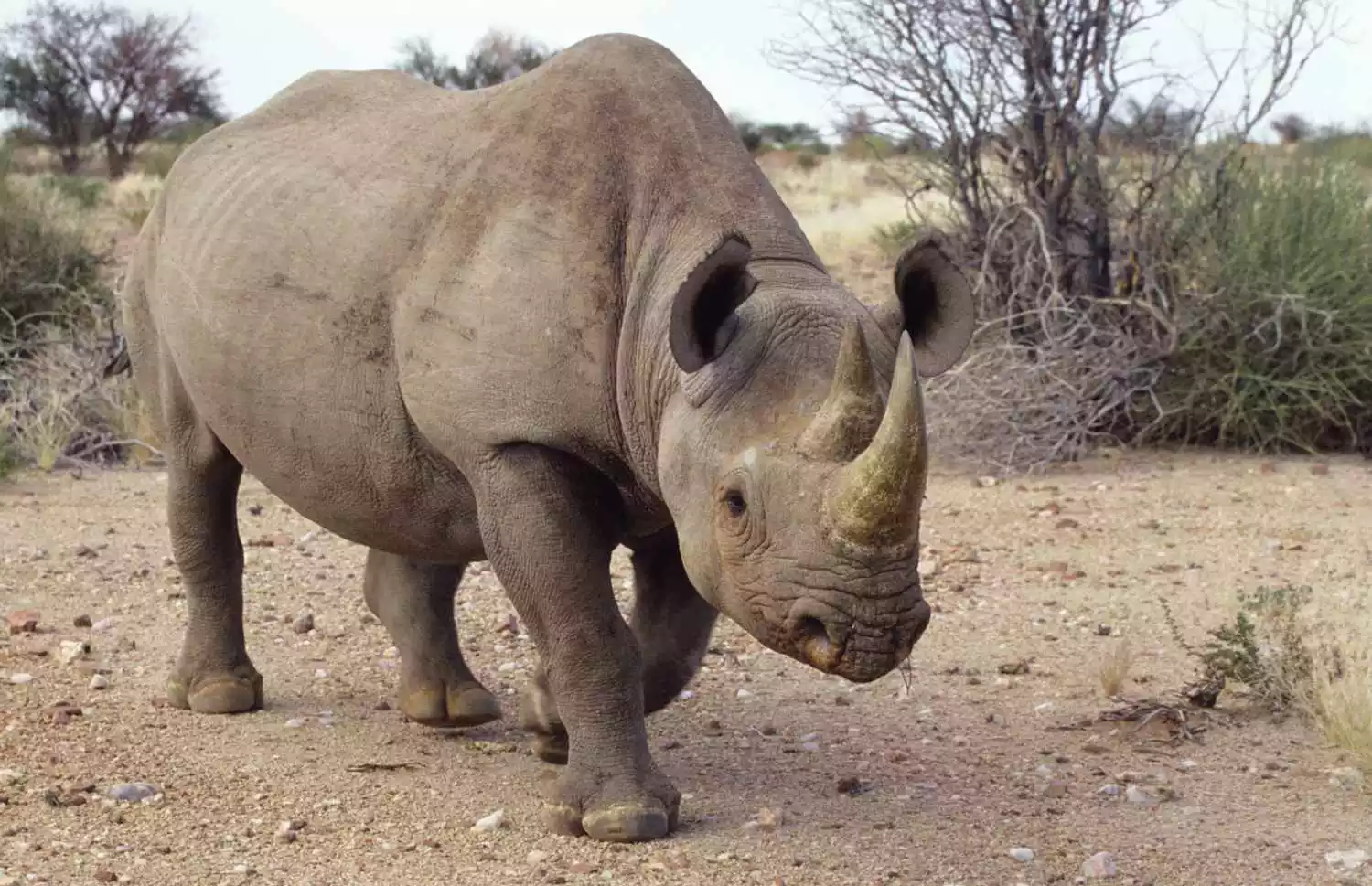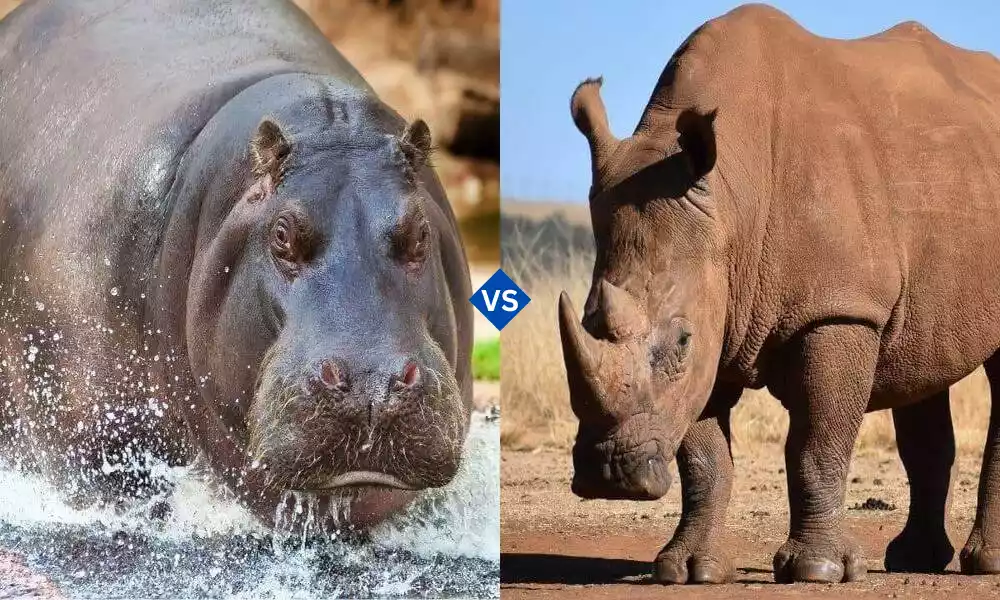The hippopotamus and rhinoceros are two of the most distinct and fascinating mammals found in the wild. The hippopotamus, commonly referred to as a hippo, is known for its large, barrel-shaped body, enormous mouth and teeth, and nearly hairless skin, often found wallowing in rivers and lakes across sub-Saharan Africa.
This semi-aquatic mammal is herbivorous, primarily feeding on grasses. On the other hand, the rhinoceros, or rhino, is recognized for its impressive size, thick protective skin, and the characteristic horns on its snout.
There are several species of rhinos, found both in Africa and Asia, varying in size and habitat preferences. While African rhinos include the black and white rhinos, Asian species comprise the Indian, Javan, and Sumatran rhinos.
Both hippos and rhinos play significant roles in their ecosystems but face threats from habitat loss and poaching, making conservation efforts vital for their survival.
Definition of Hippopotamus
The hippopotamus, or hippo, is a large, mostly herbivorous, semi-aquatic mammal native to sub-Saharan Africa. Its scientific name is Hippopotamus amphibius. Characterized by its barrel-shaped torso, enormous mouth, and teeth, nearly hairless body, and massive size, the hippopotamus is the third-largest living land mammal by weight, following the elephant and white rhinoceros.

Hippos spend much of their time in water such as rivers, lakes, and swamps, which helps to keep their massive bodies cool under the hot African sun. They are well adapted to their aquatic lifestyle, with eyes and nostrils located on the top of their heads, enabling them to breathe while mostly submerged. Despite their bulky frame and short legs, hippos are surprisingly agile swimmers and can run at fast speeds on land over short distances.
Hippos are known for their territorial behavior when in the water, but they are primarily herbivorous, grazing on grasses at dusk. Their large mouths and sharp teeth are primarily used for defense and display during territorial disputes with other hippos. Unfortunately, the hippopotamus is currently classified as a vulnerable species, primarily due to habitat loss and illegal hunting for their meat and ivory canine teeth.
Definition of Rhinoceros
The rhinoceros, commonly referred to as a rhino, is a large, herbivorous mammal identified by its characteristic horned snout. Belonging to the family Rhinocerotidae, there are five extant species of rhinoceros: two African species (the black rhinoceros and the white rhinoceros) and three Asian species (the Indian rhinoceros, the Javan rhinoceros, and the Sumatran rhinoceros).

Rhinos are known for their large size, thick protective skin, which is often formed into folds, and one or two horns made of keratin, located on their snout. They vary in size and characteristics depending on the species. For example, the white rhino is the largest and has a square-lipped mouth for grazing, while the black rhino is smaller with a pointed lip for browsing foliage.
These animals are typically solitary, except for maternal bonding with calves. They have poor eyesight but possess strong senses of hearing and smell. Rhinos are primarily grazers, with their diet consisting mostly of leafy material, although some species may consume more fibrous plant matter.
Rhinos have played a crucial role in their ecosystems, aiding in shaping the African and Asian landscapes where they are native. Unfortunately, they face significant threats from poaching and habitat loss.
Their horns are highly valued in some cultures for medicinal use and as a status symbol, leading to illegal poaching that has severely impacted rhino populations. Consequently, various species of rhinoceros are classified from vulnerable to critically endangered, making conservation efforts essential for their survival.
Comparison table of Hippopotamus and Rhinoceros
Here’s a comparison table highlighting key differences between the Hippopotamus and Rhinoceros:
| Feature | Hippopotamus | Rhinoceros |
|---|---|---|
| Scientific Name | Hippopotamus amphibius | Rhinocerotidae family (five species) |
| Habitat | Sub-Saharan Africa, near rivers and lakes | Africa and Asia |
| Size | Up to 3.5 meters long, 1.5 meters tall, and can weigh up to 3200 kg | Varies by species; up to 4 meters long, 2 meters tall, and can weigh over 3500 kg |
| Body Characteristics | Barrel-shaped body, nearly hairless, enormous mouth and teeth | Thick skin, one or two horns on the snout, skin often formed into folds |
| Lifestyle | Semi-aquatic, spends much of the time in water | Mostly solitary, poor eyesight but good hearing and smell |
| Diet | Herbivorous, primarily grazes on grasses | Herbivorous, mostly leafy material, and fibrous plant matter |
| Conservation Status | Vulnerable | Ranges from Vulnerable to Critically Endangered |
This table provides a concise overview of the two species, highlighting their unique characteristics and differences.
Physical Characteristics
When comparing the physical characteristics of hippos and rhinos, several key differences stand out:
Hippopotamus
- Size: Adult hippos typically measure up to 3.5 meters in length and 1.5 meters in height at the shoulder. They can weigh as much as 3,200 kilograms.
- Body Shape: Hippos have a barrel-shaped body with nearly hairless skin. Their skin is thick and secretes a natural sunscreen that appears reddish.
- Head: They have large heads with enormous mouths and long, curved canine teeth, which can be up to 50 cm long.
- Limbs: Short, stubby legs relative to their body size.
- Skin: Their skin is sensitive to dehydration and sunburn, so they spend a lot of time in water to stay cool and hydrated.
- Sensory Organs: Eyes and nostrils are located high on their heads, allowing them to see and breathe while mostly submerged.
Rhinoceros
- Size: The size varies among species, but they can grow up to 4 meters in length and 2 meters in height, with some species weighing over 3,500 kilograms.
- Body Shape: Rhinos have a robust, thick-skinned body, often with one or two skin folds.
- Head: Characterized by one or two horns made of keratin, located on the snout. Their heads are large and heavy with a broad mouth, especially in grazing species like the white rhino.
- Limbs: Relatively short but strong legs capable of supporting their heavy bodies.
- Skin: Thick and protective, but sensitive to sunburn and insect bites. Rhinos often wallow in mud to protect their skin.
- Sensory Organs: Poor eyesight but excellent hearing and a keen sense of smell.
While both are large, herbivorous mammals with a prehistoric appearance, hippos are more adapted to aquatic environments, whereas rhinos are primarily land-dwellers with unique adaptations for their terrestrial lifestyle.
Habitat and Geographic Distribution
The habitats and geographic distributions of hippos and rhinos differ significantly, reflecting their unique ecological adaptations and lifestyles.
Hippopotamus
- Habitat: Hippos are semi-aquatic mammals, spending much of their time in freshwater bodies like rivers, lakes, and swamps. They require water deep enough to submerge and areas with abundant grasslands nearby for grazing at night.
- Geographic Distribution: Hippos are native to sub-Saharan Africa. Their distribution is mainly centered around suitable aquatic environments in this region. They are found in countries like Kenya, Tanzania, Zambia, Mozambique, and South Africa, among others.
Rhinoceros
- Habitat: Rhinos inhabit a variety of landscapes, including grasslands, savannas, forests, and in some cases, wetlands. Their habitat preference varies among species, with some favoring dense forests and others open savannas.
- Geographic Distribution:
- African Rhinos: The black and white rhinos are found in Africa. The black rhino primarily inhabits East and Southern Africa, while the white rhino is mainly found in South Africa, Namibia, Zimbabwe, and Kenya.
- Asian Rhinos: The Indian rhino is primarily found in parts of India and Nepal. The Javan rhino is critically endangered and confined to a single national park in Java, Indonesia. The Sumatran rhino, also critically endangered, is found in isolated pockets in Sumatra and Borneo.
While hippos are confined to aquatic environments in sub-Saharan Africa, rhinos have a more varied habitat range and are distributed across both Africa and Asia. Each species of rhino has adapted to specific environments within these continents, from the savannas of Africa to the dense forests and grasslands of Asia.
Both animals face significant threats due to habitat loss and human activities, leading to various conservation statuses, from vulnerable to critically endangered.
Behavior and Social Structures
The behavior and social structures of hippos and rhinos are quite distinct, reflecting their adaptations to different ecological niches.
Hippopotamus
- Social Structure: Hippos are social animals, typically living in groups called pods, herds, or bloats. These groups can contain anywhere from 10 to 30 individuals, and sometimes even more. The groups are usually dominated by a single mature male, with the rest being females and their young.
- Territoriality: Male hippos are highly territorial in water, where they spend a significant amount of time. They can be quite aggressive in defending their territory from other males.
- Communication: Hippos communicate vocally through grunts, wheezes, and deep bellows, and also use physical displays such as yawning to show off their large teeth as a form of threat display.
- Activity Patterns: They are primarily nocturnal when it comes to feeding. Hippos leave the water at dusk to graze on grasses and return to water bodies by sunrise.
Rhinoceros
- Social Structure: Rhinos are generally solitary animals, with the notable exception of the mother-offspring bond. The degree of sociability can vary between species; for example, the white rhino is somewhat more social and often seen in small groups.
- Territoriality: Male rhinos are territorial, particularly when it comes to mating rights. They mark their territories with piles of dung and urine sprays.
- Communication: Rhinos communicate through vocalizations, including grunts, growls, and snorts, as well as through scent marking. They also employ the body as a means of communication.
- Activity Patterns: Rhinos are typically more active during the cooler parts of the day, such as early morning, late afternoon, and night. They spend the hottest part of the day resting in the shade or wallowing in mud.
Hippos are more social and have complex group dynamics, often living in large groups, while rhinos are more solitary and territorial. Both species use a variety of vocalizations and physical displays for communication, but their social structures and daily activities reflect their distinct adaptations to their environments.
Diet and Nutrition
The diet and nutrition of hippos and rhinos are tailored to their respective habitats and physiological needs, though both are herbivores.
Hippopotamus
- Diet: Hippos are primarily grazers. Their diet consists almost entirely of grass. Despite their large size and occasionally aggressive behavior, they do not eat meat.
- Feeding Behavior: They feed at night, traveling up to several kilometers to find enough food. Hippos can consume about 1.5% of their body weight in grass each night. They have large, sharp teeth and powerful jaws, but these are used mainly for defense and territorial fights rather than for eating.
- Digestion: Hippos have a multi-chambered stomach and digest their food through a process similar to fermentation, much like cows. However, they are not true ruminants.
Rhinoceros
- Diet: The diet of a rhino varies based on its species. White rhinos are grazers, feeding mainly on grass. Black rhinos, Javan, and Sumatran rhinos are browsers and eat a variety of woody plants, shrubs, and leaves.
- Feeding Behavior: Rhinos often feed in the cooler parts of the day and rest during the hotter hours. They can consume a significant amount of vegetation in a single day due to their large size.
- Digestion: Rhinos have a single-chambered stomach and rely on hindgut fermentation to digest their food. Their digestive system is well adapted to extract nutrients from tough plant material.
Both the hippopotamus and rhinoceros have purely herbivorous diets, but they employ different feeding strategies and digestive mechanisms. Hippos are nocturnal grazers focusing on grass, while rhinos, depending on the species, can be either grazers or browsers and feed on a wider range of plant materials.
Despite their formidable appearances and large size, neither animal consumes meat, relying entirely on plant matter to fulfill their nutritional requirements.
Reproduction and Lifespan
The reproduction and lifespan of hippos and rhinos are shaped by their specific ecological roles and environmental adaptations.
Hippopotamus
- Reproduction:
- Mating: Hippos typically mate in water. The dominant male in a group usually has breeding rights with the females.
- Gestation Period: The gestation period for a hippo is about 8 months.
- Birth and Offspring: Female hippos give birth to a single calf, either in water or on land. They often isolate themselves for several weeks before returning to the group with their newborns.
- Parental Care: Calves are nursed for up to eight months but can start grazing within a few weeks. Mothers are extremely vigilant about their children.
- Lifespan: Hippos typically live for about 40 to 50 years in the wild, though they can live longer in captivity.
Rhinoceros
- Reproduction:
- Mating: Rhinos have no specific breeding season, and mating occurs when females enter their reproductive cycle. Males and females usually come together only for mating.
- Gestation Period: The gestation period varies among species, ranging from 15 to 16 months.
- Birth and Offspring: Rhinos usually give birth to one calf at a time. The calf is relatively mature and active soon after birth.
- Parental Care: Rhino mothers are very protective and will stay with their calf for up to 2-3 years, teaching it how to survive in the wild.
- Lifespan: The average lifespan of rhinos in the wild is around 35 to 40 years, but they can live up to 50 years in some cases, particularly in captivity.
Both hippos and rhinos have long gestation periods and typically give birth to only one offspring at a time, reflecting their large size and the significant investment in each calf.
Calves in both species are cared for and protected by their mothers for extended periods. The lifespans of these animals are quite lengthy, particularly about other wildlife, which is characteristic of larger mammalian species.
Summary
The hippopotamus and rhinoceros are two remarkable, large herbivores native to Africa and Asia. Hippos, semi-aquatic and group-living, thrive in sub-Saharan Africa’s rivers and lakes, primarily grazing on grasses.
Rhinos, solitary and diverse across five species, inhabit varied landscapes from savannas to forests, feeding on grasses or foliage depending on the species. Despite differences in habitats and social structures, both face significant threats from habitat loss and poaching, underscoring the need for conservation efforts.





























